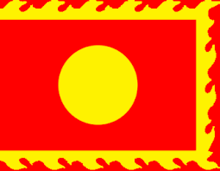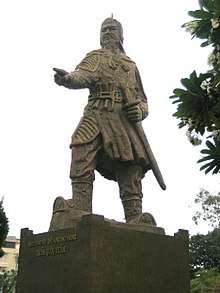Đại Việt


.jpg)
.jpg)
| History of Vietnam (geographical renaming) |
|||||||||||||||||||||||||||||||||||||||||||||||||||||||
|---|---|---|---|---|---|---|---|---|---|---|---|---|---|---|---|---|---|---|---|---|---|---|---|---|---|---|---|---|---|---|---|---|---|---|---|---|---|---|---|---|---|---|---|---|---|---|---|---|---|---|---|---|---|---|---|
| |||||||||||||||||||||||||||||||||||||||||||||||||||||||
Đại Việt (大越, IPA: [ɗâjˀ vìət], literally Great Viet) is the name of Vietnam for the periods from 1054 to 1400 and 1428 to 1804. Beginning with the rule of Lý Thánh Tông (r. 1054–1072), the third emperor of the Lý Dynasty, until the rule of Gia Long (r. 1802–1820), the first emperor of the Nguyễn Dynasty, it was the second-longest used name for the country after "Văn Lang".
History
Previously, since the rule of Đinh Tiên Hoàng (r. 968–979), the country had been referred to officially as Đại Cồ Việt (大瞿越); cồ (瞿) in the name of Gautama Buddha (瞿曇·喬達摩). The term "Việt" is the same as the Chinese word "Yue", a name in ancient times of various non-Chinese groups who lived in what is now northern/southern China and northern Vietnam ; so it means "Great Buddhist Viet". In 1010 Lý Thái Tổ, founder of the Lý Dynasty, moved the capital of Đại Cồ Việt to Thăng Long (Hanoi) and built the Imperial Citadel of Thăng Long where the Hanoi Citadel later stood.
In 1054, Lý Thánh Tông – the third Lý emperor – renamed the country to Đại Việt. In 1149 the Lý dynasty opened Vân Đồn seaport in the modern north-eastern province of Quảng Ninh for foreign trade.[1]
The Dai Viet successfully stopped attacks by the Khmer Empire, under Suryavarman II, in 1128, 1132 and 1138. A final expedition in 1150 had to withdraw before it could attack.[2]:160
The Mongolians of the Yuan Dynasty Invaded Dai Viet, three times, this became known as the Mongolian Invasions of Dai Viet. Three times the Mongolians were defeated with the last battle, "Battle of Bach Dang" being a Decisive defeat for the Mongolians having their entire fleet annihilated. Dai Viet's victories against the Mongols prevented the Mongolians from conquering south east asia, and prevented the fourth Mongolian invasion of Japan to take place, as it was destroyed in the Bach Dang River. This became one of Vietnam's Greatest Military victories in its military history.
In 1400, the founder of the Hồ dynasty, Hồ Quý Ly, changed the country's name to "Đại Ngu" (大虞). In 1407, Vietnam once fell under Ming dynasty domination, which lasted until 1427, they renamed the area "Giao Chỉ". In 1428, Lê Lợi, the founder of the Lê dynasty, liberated Giao Chỉ and once again restored the kingdom as "Đại Việt".
The name "Đại Việt" came to end when the Nguyễn dynasty took power. The country's name was officially changed yet again, in 1804, this time to "Việt Nam" (越南) by Gia Long.
Party
The name Đại Việt was also taken by one of the nationalist factions in 1936.[3]
See also
References
- ↑ Anh Tuấn Hoàng Silk for Silver: Dutch-Vietnamese Relations, 1637-1700 2007 "An embryonic independent Vietnamese administration was established and progressively renewed which laid a solid foundation for the development of the Vietnamese Kingdom of Đại Việt (Great Việt) during the Lý (1010−1226), Trần " Page 17 "In 1149, Javanese and Siamese merchants arrived eager to trade with Đại Việt. The Lý Dynasty opened Vân Đồn seaport in the modern north-eastern province of Quảng Ninh for foreign trade. It simultaneously allowed foreign merchants to ...
- ↑ Coedès, George (1968). Walter F. Vella, ed. The Indianized States of Southeast Asia. trans.Susan Brown Cowing. University of Hawaii Press. ISBN 978-0-8248-0368-1.
- ↑ Nationalist in the Viet Nam Wars: Memoirs of a Victim Turned Soldier Nguyen Công Công Luan - 2012 "When Nguyễn Hải Thần and his Việt Cách, the Việt Quốc, the Đại Việt, and others arrived in Hà Nội with their small armed forces, the Việt Minh had already established their administrative system; it was not strong, but it had spread to most of ..."